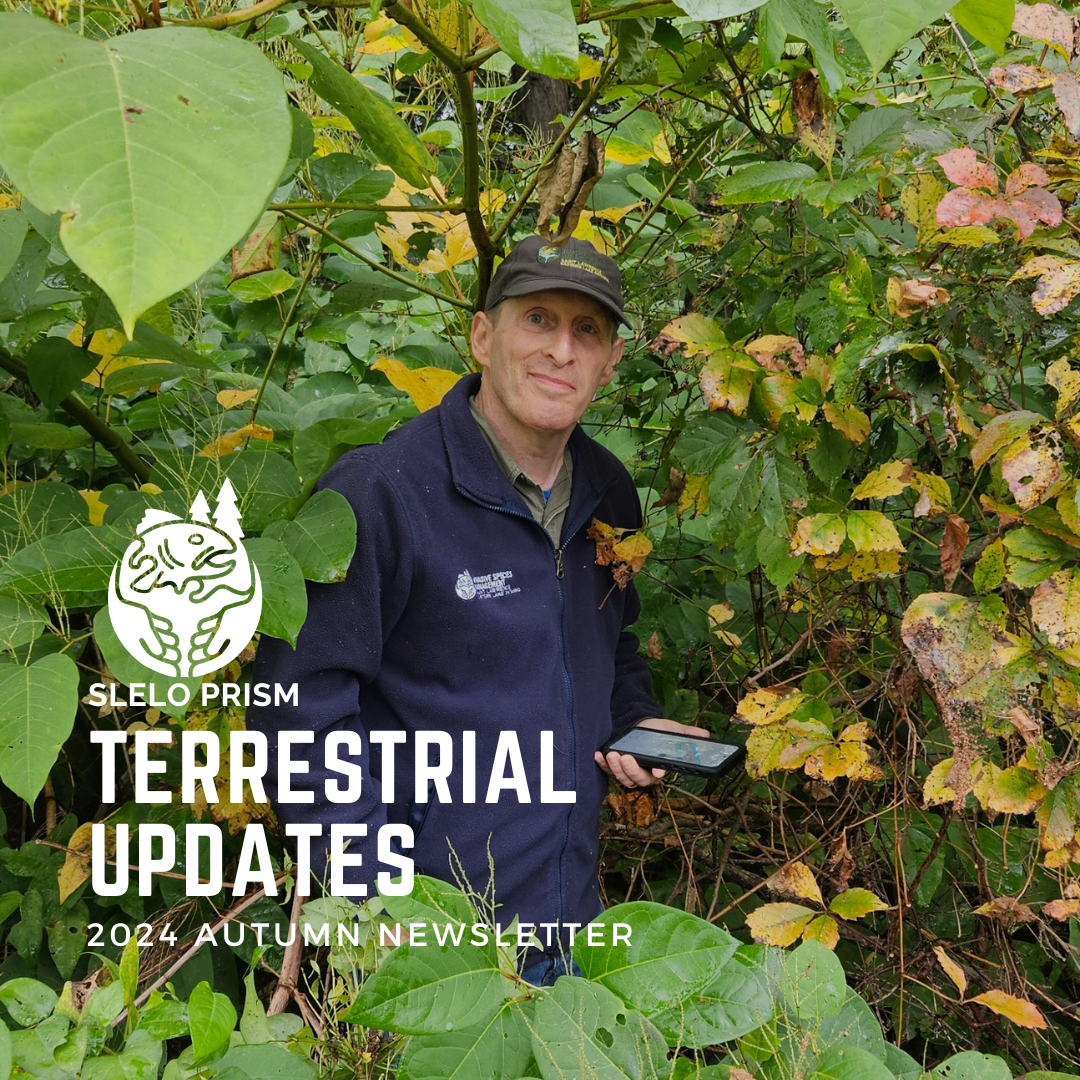This article was featured in the 2024 winter newsletter by Robert Smith-SLELO PRISM.
2024 Management Efforts Update
Giant Hogweed (Heracleum mantegazzianum):
- 39 Total Sites Monitored
- 25 Sites with no germination
- 2 Retired
- 5 Sites root cut
- 8 Sites herbicide treatment
- 1 Site with no permission to treat
Swallowwort (Vincetoxicum rossicum):
- 39 HPAs being managed
- 10 PCAs
- 118.07 Acres under management (HPA)
- 25.42 Acres of Presence Area
Knotweed (Reynoutria japonica):
- 13 HPAs being managed
- 4 PCAs
- 40.02 Acres under management (HPA)
- 6.76 Acres of Presence Area
Phragmites (Phragmites australis):
- 21 HPAs being managed
- 9 PCAs
- 27.91 Acres under management (HPA)
- 2.64 Acres of Presence Area
Bittersweet (Celastrus orbiculatus)
- 7 HPAs being managed
- 2 PCAs
- 11.69 Acres under management (HPA)
- 6.23 Acres of Presence Area
Volunteers:
- 4 PCAs being managed
- Swallowwort, yellow iris, bittersweet
- 28.21 Acres under management (HPA)
- 2.85 Acres of Presence Areas
2024 Early Detection Surveys
The 2024 Early Detection Surveys are still in progress and will finish up this month. Surveys will be completed at 11 of the PCAs this year, 4 are Terrestrial only, 5 are aquatic only, and 2 are both aquatic and terrestrial. This requires us to survey approximately 87 Terrestrial HPAs and 56 Aquatic HPAs, for a total of 143 highly probable areas, 38 of these have active treatments occurring and we have evaluated these sites for post treatment success. Also, as we have been doing in the past few years, we have conducted native species surveys at these PCAs to get a better idea of what species we are protecting and which to use in restoration area plantings.

Swallowwort Biocontrol Update
This year, we completed another biocontrol release of Hypena opulenta Moths. On May 29th, we received 150 pupae and 150 adults from the Philip Alampi Beneficial Insects Laboratory in NJ. These were divided evenly so there were 75 adults and pupae in each of the four cages (2 at Robert Wehle State Park, 2 at Grenadier Island). Mating success was high this year with Cage 1 at Robert Wehle and Cage 2 at Grenadier being removed after 85% and 90% of the leaves in the cages were defoliated.
Cage 2 at Robert Wehle and Cage 1 at Grenadier Island had fewer larvae produced in the 1st generation, so we waited a few additional weeks for a second generation of larvae to be produced. This strategy had great success in Cage 1 on Grenadier Island with 100% leaf defoliation when we removed the cage after 10 weeks. Unfortunately, the adults did not emerge to produce a second generation of larvae in Cage 2 at Robert Wehle State Park, so we removed the cage at the 30% leaf defoliation that was created by the 1st generation.
Trail Surveys were conducted this year at Robert Wehle State Park by PRISM and Park staff who each walked a third of the trail system monthly from June to August. Unfortunately, no evidence of Hypena Moths overwintering was found. Additionally, a community science program involving residents of Grenadier Island looking for Hypena moth establishment did not result in evidence of Hypena moths overwintering.



Notable Natives
Every year after the field season, we like to highlight a couple of native species that we are protecting through our invasive species management. The first is mountain death camas (Anticlea elegens var. glauca)—a threatened species in New York State. Mountain death camas flowers are star like and creamy white appearing from June to August. Up to 50 flowers appear on branched panicles up to a foot tall. All parts of mountain death camas are very poisonous and can kill both humans and animals. Some early settlers were poisoned after confusing mountain death camas bulbs with edible bulbs like wild onions.
The second species is painted-cup/scarlet paintbrush or Castilleja coccinea—an Endangered Species in New York State. It flowers early from May to August. The showy red to orange structures that people think of as the flower are technically bracts, a type of modified leaf, and not petals. Actual petals are tubular and green to yellow in color. Painted-cup paintbrush is a hemiparasite, which means it is able to get nutrients from other plants around it such as perennial grasses and other wildflowers. The tubular shape of the flowers makes them well adapted for pollination by hummingbirds. A variety of insects visit paintbrush flowers, especially bees, despite the fact that insects have a difficult time seeing the color red.
Due to a Non-Disclosure and Confidentiality agreement, we cannot release the exact locations of these species.


Please fill out the form below to be added to our listserv and receive our seasonal newsletter, event invitations and other announcements.


